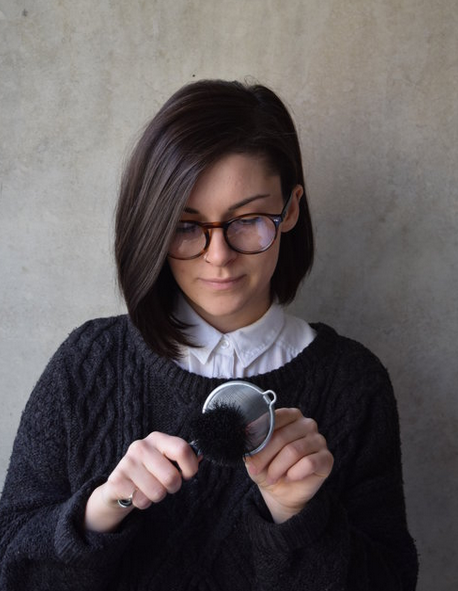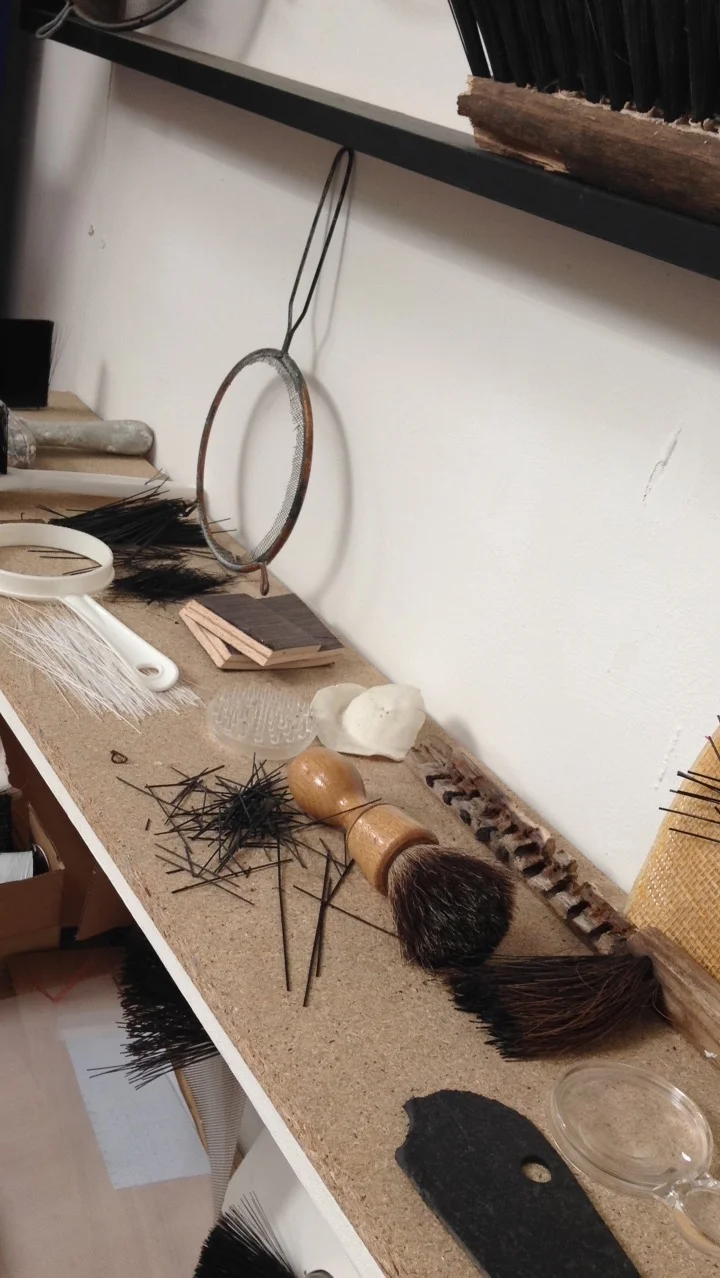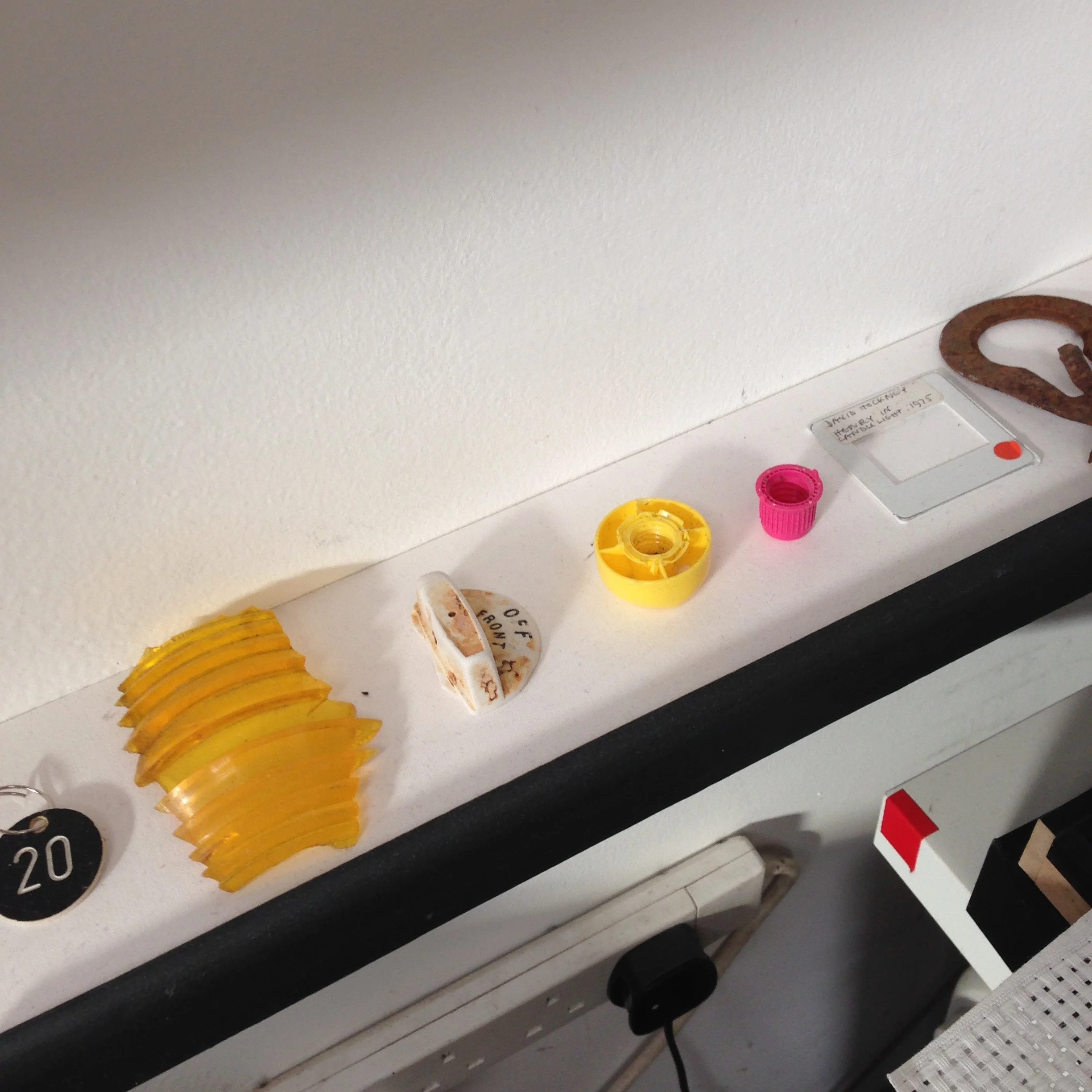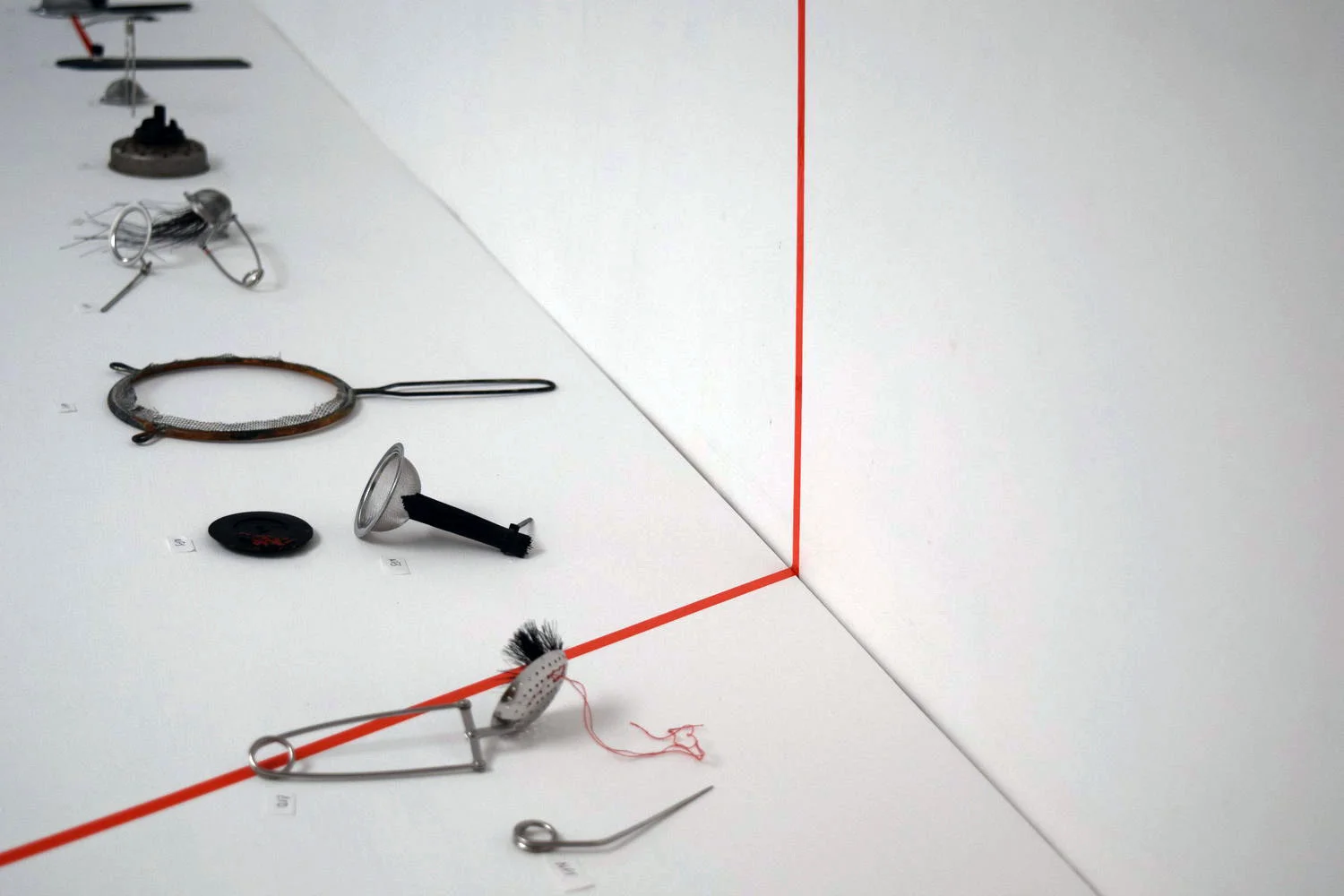Conversations with Makers is a new series on the blog.
As part of my work I regularly meet makers to discuss their creative practices and I always find the conversations insightful and inspiring. I thought maybe you would too. The act of articulating your work, to another person, regularly, is something we often overlook but which is vital if we are to remain critically engaged with what we do. Discussing your work, but also hearing other people talk about their work, helps the thinking behind the making no end.
So, once a month, I will share a conversation I have had with a maker. Next up – Charlie Birtles.
I met Charlie at New Designers One Year On this year, although I have been a secret admirer of her work for a while now. Something in her work, with its focus on ordinary objects and a meticulous approach to making, made me feel that she might be a kindred spirit, and I was eager to ask her more about her process and her relationship to found objects. I’ve recently started to question my own found object making practice and have discovered talking to other makers who work in a similar way illuminating for my inquiry. We met in Charlie’s studio, surrounded by her finds and her work. We chatted about her process of thinking through making, the joy of finding ordinary objects with a unique beauty and our shared loathing to change them in any way…
MV I’d like to know why you work with found objects – what about it do you enjoy or respond to?
CB It’s funny, because I remember when we first started Hothouse, they sent through questions for us to answer to get to know the other makers, and they asked me that and I thought, “I don’t bloody know!” But, I do know: you can pick up something and it’s recognisable and you know what it is, but there’s something about it – it may be chipped or it may be dented in one side – but that one little thing that’s happened to it, makes it interesting in some way. And I like the fact that if you pick something up off the street, there’s probably only one of them; it may be a manufactured object that was mass produced, but the fact that it’s changed in some way, makes it singular, there’s only one of them.
When I make work, I tend to work with readymades, as opposed to found objects (even though I’m informed by found objects) because of this singular nature of the found object. If I work with readymade objects that are similar to the found object, I can try lots of different things, it’s repeatable.
So, when you say ‘readymades’ you’re saying mass-produced things you can buy many of?
Yeah
Ok.
I think I figured, during my degree, that I’m not very good at designing things from scratch. I like something existing to be there. And I suppose I’m looking at things that are designed already and wondering ‘why am I interested in that?’ and responding to that in some way. And that’s why I work with found objects.
And, you mentioned earlier (which unfortunately I didn’t record) you said you could take risks with some of these things, because they already existed or that you knew there were others of them, so it wasn’t as precious. Do you think that’s part of it too?
Like I was saying, that a found object is singular, and in itself is a beautiful thing, and I like to save those qualities into other objects and explore why it’s beautiful in that way. If you’re exploring with something there’s plenty of, you can be more playful with it, you can try something with no fear of ‘getting it wrong’ because there’s loads of them…
And does that relate to the readymades?
Yeah.
So even within your found object practice, there’s two sides to it – there’s the unique, singular objects where something has happened to them and they’re one-offs, and then you’ve got the objects that relate to them, that aren’t found but you’ve appropriated them, they’re ready made, but because they’re like blank canvases that already exist, you can play and experiment and test them out…
Yes…
That’s interesting, how you take the objects and then translate them…
…it’s funny because I’ve never worked directly onto or with a found object, it’s always there as a backdrop, but I’ve never worked with it because it’s singular, and if I change that in some way it wouldn’t be how I originally found it.
Ok, so when I look up at these, that sieve, that isn’t a found sieve?
No! it was bought and got left out in the rain by accident, and then I used it.
Ah, I see! I hadn’t picked up on that. And now I’m looking round [at the objects on the wall and on shelves] I can see that with some of these. So I’m guessing you can go out and buy one of these flat mesh panels?
Yes, that was commissioned as a large scale piece and I bought the mesh.
You just said something that is almost identical to how I feel about the stuff that I pick up, which is about altering the found objects and what’s happening there. How is it that you find these objects and then you’re reluctant to do the work onto them, that it’s the readymades that become the object?
I think it’s because it’s got its own…(pauses to think) you picked it up for a reason, you thought it was familiar or beautiful in some way or you’d never seen something like that before. I dunno, I just think that in its own right, it’s a piece. And I don’t want to alter it in that way. I’m really against altering it, I don’t know why – I feel passionately about not doing anything with it!
Yeah, I get that. It’s actually quite nice to hear someone else say that!
You just mentioned about noticing things when you pick them up, and I wonder if there’s a connection between the objects you find – is it to do with how they were used, or who used them or whether they’re old or new? Are there unwritten ‘rules’ about what you will or won’t pick up?
I tend to pick up something purely off its aesthetics at first, but once you bring it back to the studio and you’re thinking ‘why do I like that?’ or other thoughts come into being like ‘what’s it meant to be used for originally?’ or ‘where has it come from?’. The questions come after the picking up.
And when you bring the objects back, I’m interested in the process. Makers who make with found objects often don’t go straight into making, they live with the objects, there is a bit of a system going on in their work space. I did want to know, what happens once you have the objects, what do you do with them?
Quite often I don’t do anything with them straight away. I find them in my coat pockets when I’ve been walking…
(MV nods along)
Ah, have you got stuff…?
(pulls out bits from pockets) Yeah, that’s from yesterday!
(laughs) Why did you pick up that one? (points at a piece of purple plastic)
It’s the colour. And I think because it’s a tube, and I often end up picking up flat things, so something that’s a bit more 3D is exciting…
And it’s got that little ridge in it as well…
Yes. But it probably won’t get used, as I’m not sure I can wear it. It will probably just live in here for a bit. [note: it’s still in that pocket 4 weeks later!]
Do you put a pin on them to be able to wear them?
No! If they can just be put straight on me…
(points to my shirt) Is that a found one?
Yeah!
I was looking at that before and thinking that’s beautiful.
And for months I couldn’t figure out how to wear it, and then I bought this shirt, and I was like ‘hey! It could slip over a button! Oh my god, I’ve figured it out!’. And it was in the process of being moved to my ‘dump box’ – which is the box of things I can’t use but I don’t want to get rid of.
Oh, ok. So you put them to one side?
Yes, and I didn’t realise I did that until I started interrogating what was happening.
I think I’ve got a ‘dump box’ up here on the shelf. I’ve just realised. Well, as you can tell there’s lots of dump boxes… oh, that’s what I was going to say: I tend to put stuff on the shelves.
And do you see that as a kind of display? – it’s not just that you plonk it down with other objects…
All those objects on that shelf there, I put together for a reason whether it be the shape or the colour or maybe it’s a contrasting colour, or a texture. That’s why those are all on that shelf together.
Would you say these shelves are almost like a 3D sketchbook? Are they informing the making, even if it’s not a directly obvious thing?
Yeah. I’ve never been very good at sketching down ideas, my sketchbooks are more the notebooks – jotting down thoughts. When I had my Hothouse interview part of it was to show your development ideas in your sketchbook, and for my ‘sketchbook’ I presented a line of found objects that I’d somehow incorporated or were reflected in the things I’d made. And I think it made that clear – it was quite good for me to lay it out like that, because made me think ‘actually there is a correlation between them all’.
Yes… saying, this is what’s happening: it’s not just a backdrop, it’s not just stuff I’ve collected that looks nice; it’s functioning, it’s doing that job…
Yes. Even if it’s not directly, but as a thought in the back.
When you’re picking things up, where do you find them? Is there a particular location or is everything fair game?
It’s always when I’m walking, maybe walking the dog. It will always be outside. I think it is pretty much ‘anything goes’ I don’t restrict myself. When I’ve been to a beach and I’ve found a couple of things, I might pick them up, but I don’t tend to pick up ‘beachy things’ but plastics that have been washed up on the shoreline. It doesn’t tend to be natural things I pick up, things that belong to the landscape, it tends to be things that have been dropped in the landscape, or there’s been some kind of human interaction that’s left it there.
And I don’t know if that’s a conscious thing or not. And I’m not really confined by place; it’s more the thing itself. Maybe it’s the material…
…yes everything looks man-made, it’s not natural things. Is there anything about the age of the things? Are you interested in contemporary found things, or historical – do they need to look like they’ve been there for a while? Would you be happy to pick up something that was dropped yesterday and is shiny new?
Do you know what? I’ve never really thought about it. But I suppose looking at the things around me some of them you can tell they might have been there for quite a while – they are rusty or are eroded. But I’m quite happy to pick up something that might have been dropped yesterday. I don’t consciously think about the historical time element of it when picking something up…
Do you think about the use of it? You said that your initial reaction is aesthetic, so when you bring it back here and you think about it, how far do you go? Do you wonder ‘what was it used for, who used it, who made it?’ how far does that thinking go for you? How much do you want to know about the object you’ve found?
That doesn’t directly lead my thought process. I’ll come back and straight away – oh that’s a knob off a cooker- some I know what it is and some I’ll have no idea, it might be a car part it could be anything. I’ll think about it, but it won’t lead the narrative of it. It’s more how it feels, how it looks, the weight of it.
In a statement you’ve written you say, this is how it feels when I touch it, this is what happens. It’s all sensory, it’s you responding to the materiality of the object. Would you say the materiality of the found objects is a driving force? That you are drawn to the qualities of the materials, the way they feel or behave or look. That engagement with the thing itself, what it’s made of. And does the making translate that? Are you gathering in that sensory evidence and then translating that?
I think that’s what I aim to do but it’s more like an instinct to it. I’m not sure that if you picked up one of my objects it would feel the same way as the original object. It’s just those thoughts are in my mind when I’m translating it into the materials I’m using.
Do all of these constructed pieces have an object ‘behind’ them, a found object that’s inspired that piece, or is it just that the found object has inspired a way of working?
I think those two original objects which started the whole thing off back at university, inspired the initial object set that I made. But it’s from there that the process has been translated, and those objects have been lost somewhere along the way. I’ve spoken to a couple of people about this, about moving my practice forwards, and they’ve asked ‘is it important, that narrative element of what the original object was?’ And I still don’t quite know. I know it’s been lost along the way somewhere. Other lines of thought come into place – like the process of repetition and tufting – other influences come in, but it’s all exploring the same material, the same quality, and the tactility. Which makes it quite difficult to explain it to someone, say at a show, they might say ‘what are all these inspired by?’ and you know what they started off with, but it’s quite hard to make that connection to the final thing. It’s a conversation with myself about how these things are moving on from each other and how they’re informing newer pieces….
But you’re also saying to me that it’s not necessarily all about these original objects. A lot of the final work seems to be so rooted in the process of making it, for you. You are choosing a lot of processes that have a lot of repetition, with these independent smaller parts that add up to a bigger whole. Adding and growing, slow and repetitive. And it is very sensory, the combinations of things that look very soft but are very hard. It looks to me that the found objects – these originating objects – may have been a catalyst for that, but that the objects are really about the process of making, not just a response to brushes in the past, or things that you have found. It’s taking that and turning it into a way of working, rather than just an aesthetic starting point.
Yes, it does make sense how you said that. I’m nodding along, like ‘yes, that’s what I’m doing!’. It’s interesting because when I describe my way of working I use the term ‘thinking through making’ and I feel like that is what I do. The fact that’s it a repetitive process, and quite time-consuming, allows that space to think about what I’m doing, and how it’s forming around me.
When you show your constructed work, do you display the found objects with it, to provide a context?
When I first starting working with found and readymade objects at uni I began by displaying the original object with the pieces I’d made, as that way of communicating a context or where it had come from, but that never carried through to post-graduation. Even now, I never showcase original found objects with my work. I don’t know if that’s a conscious thing, that I don’t want the two to be mixed together, or whether that’s been lost along the way somewhere so it’s not as relevant… I might make reference to them in some cases, but I don’t think I’ve ever posted a photo of a found object on my Instagram feed or on my website.
And maybe it can be confusing for people to know which is the work- there are artists that mix the pieces they’ve found with the work they make, in a seamless way, and you still wonder which is which. But maybe it doesn’t matter. Is it important to you that people know that the work has been inspired by found objects?
I don’t think I’m sure at the moment. It’s interesting for me to talk to you about this, because you’re learning things about my process and inspiration from being here, and I think you’ve learnt a lot more about the work because of seeing the things behind it. Even talking to you, it feels like it’s given more insight into what the pieces are. In that way, it makes me think that it is important. On Hothouse they always talked about your story – ‘what’s your story as a maker’ and I know it’s important, but it’s hard choosing what’s important to communicate as a maker and your brand, but I don’t think I’m there yet in understanding.
And looking forward, what kind of big visions do you have for your work? If I could do anything with it, what would you ideally want it to become?
I’d love to do Collect Open in a few years’ time, and for that to be a big installation piece that has that wow impact. And I’d love to be able to show everyone my process behind this work too, so I’d love to find a residency where everything could just be out… I know that’s so generic, saying ‘a residency’ but I like that contrast between the two things, that I can make something that’s an experience in itself, but I can also make something that is a visual exploration.
And because the material, and the tactility, and the process of making all relates to how you interact with the materials – do you want people to engage with your objects in that way, or do you see them more as aesthetic objects that you display on a shelf or on a wall?
I think my work screams out for that sort of social interaction and seeing how people engage with them might change my way of working or the outcomes. Maybe it could have a digital element with it so things can be moveable. Lots of avenues that could be explored. That’s one thing that I’ve begun to understand about my work is that the tactility and the interaction with it, helps to bridge that information gap of where it’s come from.
I’m looking forward to seeing what happens…
I’ve got a couple of projects lined up for next year, one is a public engagement project in Manchester, where I respond to an archive and there will be an exhibition for my pieces, with the public’s pieces alongside.
For the pitch, I spoke about my work now, but the things I took out my work, I tried to pick out words that sum up my work as a maker, words like meticulous, process, nostalgic and stuff like that, to describe what the work might be like in response to this archive. But I will make other things, too. It will be interesting to see what I create then, separate from my main work.
That sounds exciting. Will you be working with the public?
Yes, the project is about a scientist JP Joule and there’s a collection of all his scientific journals and writing. It’s interesting to see his methodical approach, and the journeys he went on. But they also have some objects in the Museum of Science and Industry, which are to do with electromagnetism. So it’s using those archives and developing an engaging programme off the back of that. And there’s an opportunity to engage with young people. I’ll make work and they’ll make work, and then there will be an exhibition alongside artists who are making other work. We’re still waiting to hear about funding, but hopefully it will start in June and carry on to October when there’s a science festival in Manchester.
Charlie Birtles creates artworks of curiosity. Inspired by miscellanea, from a compulsion to find and collect, she endeavours to explore value and meaning of unsung objects.



